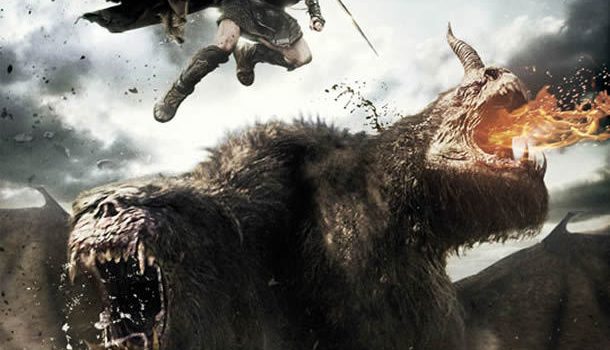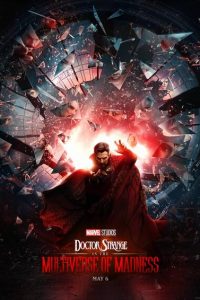Twilight of the Gods, and Monsters: A Review of Wrath of the Titans
by Gary Westfahl
 If people go to movies in order to be excited, they should definitely see Wrath of the Titans, for no one can deny that it is a tremendously exciting movie; they may not always understand precisely what is going on, but if one thrill is disappointing, they can be sure that another one is on its way, after a brief pause for exposition or character development. There are even signs that somebody cared a little bit about the quality of the dialogue and the acting, which are rarely prioritized in movies that focus on providing excitement. However, filmgoers searching for interesting ideas in this film may feel, like its protagonists at one point, that they are lost in a vast labyrinth, filled with empty corridors, although dogged investigation may yield some modest rewards.
If people go to movies in order to be excited, they should definitely see Wrath of the Titans, for no one can deny that it is a tremendously exciting movie; they may not always understand precisely what is going on, but if one thrill is disappointing, they can be sure that another one is on its way, after a brief pause for exposition or character development. There are even signs that somebody cared a little bit about the quality of the dialogue and the acting, which are rarely prioritized in movies that focus on providing excitement. However, filmgoers searching for interesting ideas in this film may feel, like its protagonists at one point, that they are lost in a vast labyrinth, filled with empty corridors, although dogged investigation may yield some modest rewards.
One subject to explore is the persistence of ancient tropes, despite visible efforts to modernize old stories for new audiences. As some might recall, the remake that inspired this sequel, Clash of the Titans (2010) (review), took the traditional, all-powerful Greek gods of the original Clash of the Titans (1980) and recast them as unjust authority figures that ordinary people should, and could, successfully challenge, appealing to our contemporary distrust of authority figures and admiration for surly young rebels like that film’s Perseus (Sam Worthington, who returns to the role here). In a sense, Wrath of the Titans maintains that theme, since its gods, like Zeus (Liam Neeson) and Hades (Ralph Fiennes), are no longer being strengthened by the prayers of worshippers and hence are rapidly losing their powers and even their immortality. Thus, Zeus must ask for Perseus’s assistance in confronting the threat of his reemerging father, the fiery, brobdingnagian Kronos. And, as a sign that humans are now controlling their own destiny, here it is not the gods but Queen Andromeda (Rosamund Pike) who plays chess, demonstrating her human mastery over other humans (in contrast to the gods’ mastery over humans), since her moves apparently correspond to the movements of her soldiers. Yet this film also, strangely, validates the whole concept of gods, since it turns out that they have been playing the valuable role of keeping Kronos and other menaces (like unspecified “demons”) under control, and their growing weakness means that humanity now faces a host of lethal new foes about to be unleashed. When one further considers that all of the film’s major gods – Zeus, Poseidon (Wally Huston), Hephaestus (Bill Nighy), and even Hades – are ultimately presented as sympathetic characters, this film is implicitly arguing that, perhaps, worshipping gods and keeping them strong wasn’t such a bad idea after all. (Indeed, Zeus’s appearance and positions at times seem almost Christ-like, as if he is suffering solely in order to benefit humanity.)
More to the point, this film, like its predecessor, refuses to take this argument to its logical conclusion – that ordinary people, having freed themselves from their arbitrary divine overlords, would then naturally seek to free themselves from their arbitrary human overlords as well. Instead, monarchy remains the accepted form of government: no one questions Andromeda’s rule, because she is not only of royal blood, but she also proves her worthiness to command by being a brilliant military leader and courageous fighter who accompanies Perseus on his quest to rescue Zeus and defeat Kronos. Further, filmgoers will quickly figure out that, this time around, Andromeda is going to play her traditional role as Perseus’s love interest (a big hint: the part has been recast as a beautiful blonde), which means that he is destined, as in the original myth, to eventually marry Andromeda and become a king, renouncing his previous determination to live as a humble fisherman. And no one will question his rule either, since his divine heritage, and proven ability to slaughter monsters, demonstrate that he is also superior by birth and hence deserves to become an absolute ruler. Granted, given the nature of the film under consideration, it is senseless to rail against the political implications of Wrath of the Titans, especially since countless other fantasies display the same sympathies; still, it is striking to see them surface again in a film series that originally seemed determined to reflect democratic values. (And parenthetically, one might add, everyone devoted to the genre of fantasy will someday have to engage in some soul-searching about the fact that their favorite form of literature is devoted to celebrating a system of government that almost all contemporary citizens of the western world would righteously abhor if instituted in their own country.)
The film also displays a conflicted attitude toward another form of authority involved in its creation, namely, the ancient Greek myths that inspired its story. The official closing credit that its screenplay is based on “characters created by Beverley Cross” (who scripted the 1980 film) might suggest that the filmmakers knew little about Greek mythology, for in fact, there is precisely one extremely minor “character” in this film, to be mentioned, that Cross arguably created, while all the others date back to ancient Greece or were concocted by this film’s writers, Greg Berlanti, David Leslie Johnson, and Dan Mazeau. However, when it was decided that Perseus needed an untrustworthy sidekick in this film who was also a demigod, the writers might have invented any character they chose; instead, they bothered to do some research and located an actual, but very obscure, mythical figure, Agenor (Toby Kebbell), who was in fact described as a son of Poseidon and was in fact an unsuccessful suitor of Andromeda in the original Perseus story, as he is in this film (though the mythical Andromeda originally preferred Agenor to Perseus, while the film’s Andromeda throws him in prison). Other details are consistently correct: Zeus, Poseidon, and Hades were the three sons of Kronos; Aphrodite was the wife of Hephaestus; there were originally three giant Cyclops, as seen in the film, and their association with Hephaestus is logical since all four figures were known for forging weapons; and Perseus did have a son named Helius, though his name is usually spelled Heleius, distinguishing him from the sun god. (My authority for all of this information, by the way, is Robert Graves’s The Greek Myths [1955], which in my old-fashioned way I trust more than Wikipedia.)
In other ways, however, the film visibly departs from tradition. For one thing, the original Kronos was not exactly a pleasant fellow – advised that one of his children was destined to overthrow him, he swallowed the first five, though the youngest one, Zeus, escaped this fate, got Kronos to vomit up his siblings, and led their successful revolt against him; however, while he was, by one tradition, imprisoned in the underworld of Tartarus, as in the film, there are no grounds for presenting him as a mindlessly destructive giant, this film’s equivalent to its predecessor’s enormous Kraken that Perseus must defeat after he is released. Also, the weapon traditionally associated with Hades is a “helmet of darkness” (or invisibility), not a “pitchfork,” but such a passive weapon, one supposes, was deemed insufficiently conducive to the bloody mayhem required in all action films. Finally, Hephaestus sends Perseus, Andromeda, and Agenor into an enormous underground labyrinth that he constructed as the only way out of Tartarus, and thus is the only way they can enter Tartarus to effect Zeus’s rescue; and once therein, Perseus is suddenly attacked by a bull-headed humanoid who is of course the Minotaur. Hey, someone must have thought, this is a labyrinth, there was a Greek myth about a Minotaur in a labyrinth, wasn’t there, so why not put a Minotaur into this one? But the labyrinth containing the Minotaur was in Crete, not the underworld, and the monster was deliberately placed there to be well fed by the annual sacrifice of a young man and woman; a Minotaur who somehow found his way into Hephaestus’s labyrinth would have been alone for millennia in its unused passageways and presumably would have long ago starved to death. But like the equally senseless dinosaurs that attack underground travelers in Journey to the Center of the Earth (review), the Minotaur shows up solely because films like these have to have some action every ten minutes or so, regardless of whether or not it makes any sense.
There are, as it happens, several things in this film that don’t make a lot of sense, though some matters might have been clarified if the screenwriters and director Jonathan Liebesman had had the courage to slow down the pace a bit and provide a little more in the way of explanation. In the previous film, the beautiful Io was described as immortal, but since she must be gotten out of the way to make room for Andromeda in this film, she is somehow killed off and buried before the film begins. (If they had really wanted to be contemporary, the filmmakers might have had Io angrily storm off, complaining that when she married the heroic Perseus, she never expected having to endure the dreary life of a humble fisherman’s wife; but like democracy, it seems, divorce can never be introduced into fantasy films.) We are further told that if Perseus combines Zeus’s thunderbolt, Poseidon’s trident, and Hades’s pitchfork, he will create the “spear of Trium” that can destroy the evil Kronos. Yet, if their weapons had this power, why didn’t Zeus, Poseidon, and Hades simply kill their hated father centuries ago, instead of imprisoning him in Tartarus? When Kronos emerges from captivity, some strange, two-bodied monsters also start attacking Andromeda’s soldiers, though their nature and motives are never explained. The last four problems identified could each have been addressed with a single line of added dialogue (Perseus: “Somehow, this labyrinth must be connected to the labyrinth in Crete”; Perseus: “To marry me, she had to give up her immortality”; Zeus: “We hesitated to kill Kronos before, out of misguided filial loyalty”; Andromeda: “Kronos has brought his demons to attack us”), perhaps lengthening the film by a total of thirty seconds. But no one wanted to delay, even briefly, the arrival of the next monster or the start of the next swordfight. In part, also, the absence of explanatory dialogue stems from the decision to present Perseus as a laconic, inarticulate figure, disinclined to say anything even when it would seem natural, or helpful to an understanding of the story. (For example, after his encounter with the Minotaur, he is asked “what happened?” but says not a word in response.) Perseus’s personality is summed up an exchange with Agenor as they prepare for the climactic battle: “Don’t give me the big speech,” says Agenor. “I wasn’t planning to,” Perseus replies. Yet big speeches can contribute significantly to the narrative flow and atmosphere of fantasy films, and big speeches didn’t seem to diminish the entertainment value of, say, the Lord of the Rings films. It seems strange that the filmmakers were determined to flout tradition in this minor respect, while dutifully following tradition in more significant ways.
Still, I am glad that they followed one minor tradition of this film series, an appearance by the mechanical owl Bubo, so that all three films include a special effect constructed by Ray Harryhausen, the true architect of the 1980 film that inspired these recent productions (though Bubo could also be described as a “character” from Cross’s script, justifying the aforementioned credit). In the 2010 film, Bubo is an artifact in a depository of weapons that Perseus ignores, suggesting (as I said in my review) an intent to transcend the occasional childishness of Harryhausen’s film to adopt a more mature attitude; here, Bubo is Hephaestus’s mute, motionless conversation partner (appropriately enough, since he is the god who built Bubo in the 1980 film), suggesting that the weakening gods are becoming senile and a bit childish themselves, in contrast to mature humans like Perseus. (The impression is heightened by the over-the-top performance of Bill Nighy, who earlier portrayed the distracted Slartibartfast in the farcical The Hitchhiker’s Guide to the Galaxy [ review ], and who here resembles Michael Palin playing a god in some absurd Monty Python sketch.)
While Nighy’s Hephaestus provides the film with some brief, and jarring, comic relief, the film as a whole is relentlessly grim, particularly in its battle scenes, which constitute another departure from tradition in recalling modern warfare more than the conflicts of ancient Greece. The film’s villages and encampments are periodically afflicted by strange fireballs that function like guided missiles; blasts of destructive energy are like those from a nuclear bomb; mounted on the flying horse Pegasus, Perseus surveys a dauntingly devastated landscape; and huge fiery explosions accompany every attack by colorful monsters. Carefully edited, some scenes from this film could be taken as footage from the recent carnage in Syria, making Kronos and his cohorts seem far more sinister than the menaces in Harryhausen’s films. In addition, reflecting the realities of contemporary combat, characters suffer some serious wounds in this film; Perseus requires several stitches after fighting a two-headed monster, and even the decorous Andromeda is seen with a bloody bandage on her arm in the final scene. In combining the fanciful creations of computer-generated animation with such realistic damage and destruction, Wrath of the Titans again seems a film compelled both to honor tradition and to break with tradition.
The film finally raises one more question related to traditions, specifically the traditions of Hollywood: if this film proves successful (and it just might, since word-of-mouth reviews regarding the adrenalin rush it offers might be more persuasive than critical dissections of its flaws), will the producers start working on another sequel? On this issue, like so many others, the filmmakers seem at odds with themselves. On one hand, certain aspects of this film’s plot – like the seemingly complete collapse of the Olympian gods, and the death of one key character – suggest an intent to bring this saga to an end; on the other hand, with at least one god surviving, and with a son of Perseus ready to serve as a new hero should Worthington tire of this role, the door to one or more sequel was not entirely closed. Still, my guess is that everyone involved in Wrath of the Titans will now choose to look at some new properties instead of seeking to earn more cash from the titans. Indeed, I sensed at times that this film’s elegiac tone, with ruins and broken statues observed in every setting, reflected someone’s conscious or subconscious intuition that this sort of bombastic, even operatic fantasy film may be becoming passé, ready to be supplanted by edgier, more intimate sorts of adventures. And if that is the case, the broader lesson to be learned from all three films I have examined this month may be that it is now more profitable, and more aesthetically pleasing, for filmmakers to adapt stories that were recently and specifically designed for contemporary audiences, like The Hunger Games (review ), instead of struggling to revisit and revamp classic tales that were popular long ago, like John Carter (review )and Wrath of the Titans. Needless to say, this is not the sort of lesson that an old titan wishes to hear, but no one devoted to science fiction should ever be afraid of, or unwilling to acknowledge, change. So, we may forever cherish the old games, but it is also time to let the new games begin.









Pingback:Vampire News » Blog Archive » Twilight of the Gods, and Monsters: A Review of Wrath of the Titans – Locus Online
A very interesting essay, but you should correct the release date of Harryhausen’s version of “Clash of the Titans” from 1980 to 1981.